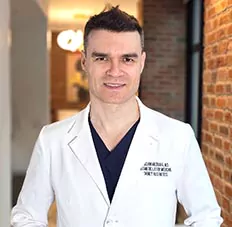Stretch Marks
For so many people, stretch marks are just a fact of life. 50% to 90% of women exhibit stretch marks – also known as striae – as a result of pregnancy, but even those who have never been pregnant often have some level of stretch marks on their body; while it’s more prevalent in women, plenty of men have stretch marks, too. Ranging from pink to white or even bluish in color, stretch marks can appear like tiny lines or thick claw marks in the skin. Despite their prevalence, many of us who have dealt with stretch marks often which we didn’t have to. These pigmented grooves in the skin can be incredibly frustrating, especially because they can often seem difficult to prevent, and simply impossible to get rid of.
The good news is: you can actually significantly diminish the appearance of stretch marks! You just have to know where to look. It’s time to stop revolving your outfit and activity choices around hiding and disguising stretch marks. There are plenty of ways to treat striae to the point of it no longer being a concern for you. Let’s get into the nitty gritty and discuss what works, what doesn’t, and why stretch marks happen in the first place.
What Are Stretch Marks?
Stretch marks are hardly a rarity. They are those crooked bands of dermal tissue – usually reddish or white in color – that run along areas of the body that have experienced growth or shrinkage. Stretch marks can look like scars, or like lines of static buzzing under the skin. Some are barely noticeable, others form deeper, clearly visible indents in the body. These bands are most common along regions of the body that store the most fat, such as the abdomen, thighs, butt, back, axillae, breast, and groin area. For most adults, stretch marks are a basic fact of life – whether we like it or not.
Stretch marks go by many names. You may have heard them being affectionately called tiger stripes. In the medical community, stretch marks are referred to as striae, which can be further classified into more specific categories: striae distensae (in the case of stretched skin) or striae atrophicans (in the case of thinned skin), for example. Stretch marks following pregnancy are known as striae gravidarum. They can also be distinguished by their hue: striae rubrae, striae albae, striae nigra, and striae caerulea – these denote red, white, black, and dark blue stretch marks, respectively. Stretch marks can also appear purplish or brown, especially when they first show up.
While stretch marks are extremely common, they can be a major source of insecurity for a lot of us. These unsightly streaks can crop up at any time throughout your life, usually because of weight loss, gain, pregnancy, or puberty. And once they arrive – often fairly suddenly – it feels like they can be impossible to get rid of. There is a huge sector of the beauty and cosmetics industry dedicated to eliminating stretch marks; we are often desperate to cover them up or edit them out of photos, wanting instead to show off clear, smooth, unblemished skin. Even though stretch marks are harmless and can even fade somewhat over time, the strife to get rid of them is a continuing struggle for so many of us.
Why Do I Have Stretch Marks?
In short, stretch marks are the result of alterations to the collagen and elastic tissue that make up your skin. Stretch marks form mainly through fluctuations in body size – that can be weight gain or loss, as well as growth spurts. When skin expands or shrinks rapidly, collagen and elastin – the main proteins that make up the structure of our skin – can break apart. During the wound-healing process, stretch marks develop. This is why so many people notice stretch marks after puberty or pregnancy, or after undergoing extensive lifestyle changes.
It’s possible that certain hormones contribute to the formation of stretch marks. Adrenocorticotropic hormones are responsible for increased protein catabolisms – meaning the breakdown of proteins such as collagen and elastin – disturbing the structure of the skin. Decreased serum relaxin and fibrillin – more common in pregnant women – is also proposed contributor to stretch marks. Many people are also genetically predisposed to stretch marks; naturally lower levels of collagen and fibronectin genes indicate a higher chance of developing stretch marks.
Stretch marks aren’t a health risk and are not usually an indication of poor health. However, certain disorders can also make you more susceptible to developing stretch marks. Marfan syndrome and Cushing’s disease, for example, can be an underlying causes. These are connected to elevated cortisol levels; high levels of cortisol (also known as the stress hormone) may make elastin fibers in your body weaker, affecting the stretch and strength of the skin. The lengthy application of a corticosteroid to your skin can have a similar effect.
It’s a myth that stretch marks only befall those who are overweight; people of any body type can have stretch marks. Even those who work out vigorously can end up with tiger stripes where there has been a swift growth in muscles. While having stretch marks isn’t a cause for worry, it can be a major cosmetic concern for many of us. It can be a deterrent to wearing bikinis or revealing clothing, which is especially disappointing if you’ve been working hard to get the figure of your dreams and don’t even feel confident enough to show it off. Body makeup still has a long way to go, and it’s nearly impossible to disguise textural changes in the skin. That’s why we have gathered the most popular stretch mark treatments so that you can get your mojo back.
How Can I Treat Stretch Marks With Non- or Minimally Invasive Cosmetic Procedures?
Radiofrequency Microneedling (Morpheus8 and Secret RF)
How Does Radiofrequency Microneedling Treat Stretch Marks?
Radiofrequency technology (such as Secret RF or Morpheus8) has come a long way in terms of improving the overall appearance of the skin. It’s commonly used to treat acne scars, wrinkles, unwanted lines, skin laxity, cellulite, and stretch marks. This minimally invasive treatment combines traditional microneedling – in which extremely fine needles penetrate the skin at rapid intervals to provoke a wound-healing response – with radiofrequency energy pulses; this adds a thermal energy component. Miniature columns of thermal coagulation and micro-lesions encourage skin to replenish itself, creating new collagen to replace the hydrogen bonds of collagen that have been broken by micro-damage. New tissue is formed with heightened levels of elastin and collagen, giving skin a renewed and smoother appearance over time. Thermal energy also encourages the overlaying fibroseptal network of the skin to tighten; by firming and strengthening skin, the divots that make up tiger stripes are minimized.
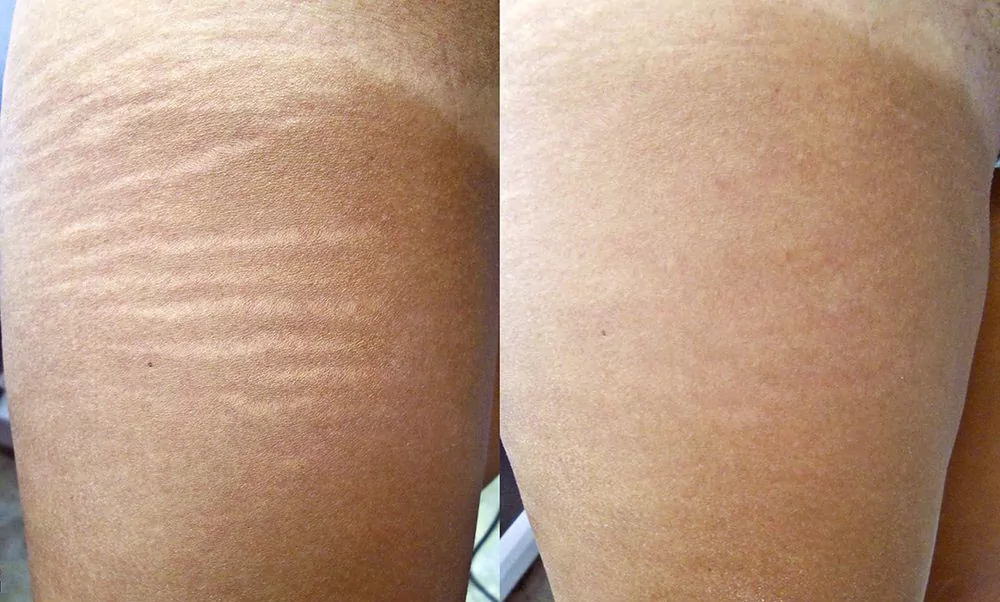
Radiofrequency Pros
- RF microneedling has a high satisfaction rate amongst patients, with 93% of those who have undergone the procedure reporting being happy with the outcome.
- Radiofrequency microneedling operates on multiple levels, combining traditional physical puncture wound healing with advanced controlled thermal damage for an enhanced bodily response.
- Thinned-out areas of skin that make stretch marks more visible can be thickened and toughened using RF microneedling.
- Other than being gentle on your skin, there is little you need to worry about in terms of prep or downtime following your RF microneedling procedure.
- Apart from some redness, bruising, and swelling, there are a few side effects associated with this procedure.
Radiofrequency Cons
- While RF microneedling can be beneficial for many, others are not ideal candidates. For example, those with collagen vascular disorders, active infections, or poor wound healing should avoid this treatment.
- If you deal with cystic acne, it’s possible that RF microneedling will irritate your skin and cause you to break out, particularly if used in the face.
- RF microneedling can help reduce the look of stretch marks, but it may not make them go away completely.
- This procedure requires patience; you will have to wait a few months for the results to truly shape up.
Microneedling
How Does Microneedling Treat Stretch Marks?
Microneedling works to rejuvenate skin by triggering the body’s healing response. Miniature puncture wounds from tiny, sterilized needles attached to a hand-held device create small zones of micro-injuries in the affected areas of skin. This handheld device – the dermapen, which functions like a pulsing stamp – can be adjusted to specific puncture depths in order to target different concerns and types of scarring. These microinjuries cause miniature cell deaths -apoptosis – in which targeted cells in the superficial dermis shrink and break apart; white blood cells and fibroblasts swoop in to form new, collagen- and elastin-rich, matrix-like tissue. The resulting dermal tissue is more smooth and even more than before. You can get microneedling at multiple clinics including MiracleFace MedSpa in New York.
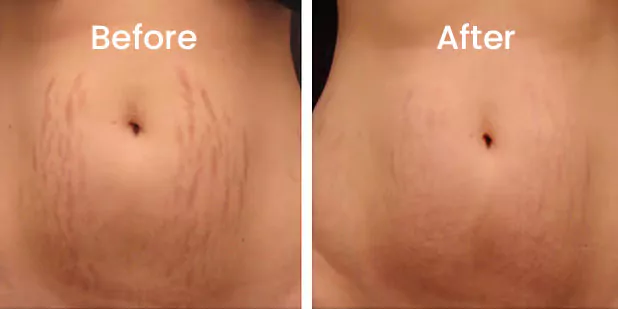
Microneedling Pros
- Microneedling is versatile; it can be specified to different depths and penetration speeds to address different types of scarring in different areas of the body, including stretch marks.
- Microneedling is minimally invasive, meaning it is a low-risk and generally painless procedure that doesn’t disrupt your daily life.
- Microneedling is quick – with a single session being around 30 minutes – and requires no downtime or prep time.
- Microneedling can also be used as a preventative measure to evade signs of aging and boost collagen in the skin.
- Microneedling can be used to treat hyperpigmentation as well as textural stretch mark concerns, resulting in more airbrushed looking skin.
- It is more cost-effective than a lot of other treatment options, with a single session being around $500 to $1000.
Microneedling Cons
- There are some contraindications that can bar you from this procedure, including medical conditions that disrupt wound healing (like diabetes), active infections, active cystic acne, or wounds in the targeted region, and herpes. Pregnant individuals are also discouraged from microneedling.
- If you are prone to hypertrophic or keloid scarring, microneedling may worsen the issue.
- Some minor side effects include temporary redness, swelling, and dryness following the procedure.
- Poorly performed procedures may result in postinflammatory hyperpigmentation or further scarring that can be difficult to fix.
- Microneedling likely won’t make your stretch marks disappear completely, but it can reduce their appearance.
Ultherapy
How Does Ultherapy Treat Stretch Marks?
Similarly to microneedling and RF microneedling, Ultherapy jumpstarts the collagen synthesis process to bolster the strength and silkiness of the skin. Unlike the other two treatments, Ultherapy is completely non-invasive, which results in an even lower-risk procedure. Ultherapy targets stretch marks by delivering beams of ultrasound energy at different frequencies into the superficial muscular aponeurotic layer (or SMAS) of the skin. These beams cause microscopic thermal damage that triggers the production of collagen and elastin, major players in given the skin its supple structure. Due to the ultrasound energy being focused on the subcutaneous region of the skin, the superficial papillary dermal and epidermal layers of the skin remain unharmed, while the underlying structure that contributes to the appearance of stretch marks is treated. This occurs over the course of several months as the body’s natural healing process takes place.
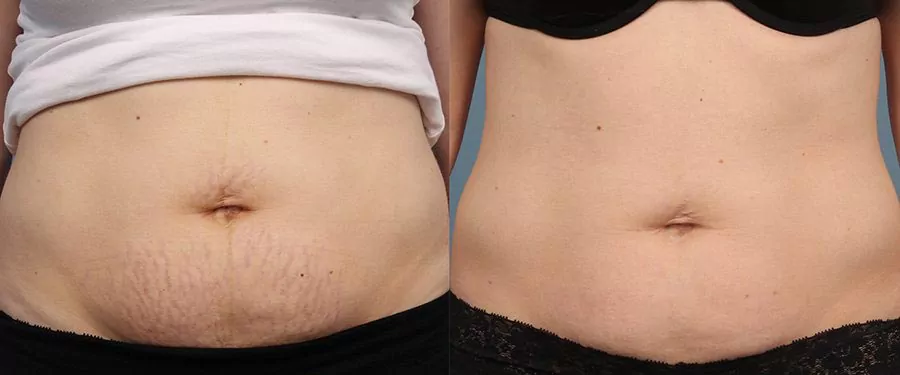
Ultherapy Pros
- This non-invasive treatment reduces the look of stretch marks while plumping the skin for a youthful glow.
- An Ultherapy procedure is speedy; it can be done in 30 to 120 minutes, requiring no prior preparation or recovery time after.
- Ultherapy generally has a low-risk of side effects; it is FDA approved and tends to be considered safe for most patients.
- Ultherapy can be an effective solution for treating stretch marks that avoids any kind of injections, punctures, incisions, or surgical intervention.
Ultherapy Cons
- As with any cosmetic procedure, Ultherapy does have a few possible side effects – transient edema and erythema are common.
- An Ultherapy session can be uncomfortable or painful, a side effect that can be minimized with topical lidocaine or painkillers.
- More serious side effects include temporary or permanent nerve damage or numbness when too much energy is applied. Postinflammatory hyperpigmentation or scarring is more rare, but can also occur.
- Appointments can be pricey, costing anywhere from $1000 to $20,000 for the best outcome.
- You may need multiple sessions to start seeing your desired results, and it takes a while for collagen build-up to become apparent.
Fraxel Laser
How Does Fraxel Lasering Treat Stretch Marks?
Fraxel lasers treat skin concerns by delivering pulsing light beams through miniscule channels of the skin; this causes controlled contractions and tightening of the skin while leaving surrounding tissue unharmed. The laser stimulates fibroblasts – which are responsible for the production of collagen and elastin in the body. This can bring about thicker, more durable skin, and also reverse defective pigmentation. Varying wavelengths allow for this treatment to be highly specified for different concerns, such as pigmentation, wrinkles, or scarring. For stretch marks, for example, it’s likely your provider will use the 1550 nm Erbium wavelength; it penetrates deep into the skin to target volume issues such as scarring and striae. More superficial stretch marks can be reached with the weaker 1927 nm laser, which mainly targets pigmentation concerns. Through collagen synthesis and elastin remodeling, fraxel lasers get to work creating an improved, smoother, and healthier skin profile. Dr. Schwarzburg at Skinly Aesthetics explains that Fraxe proved itself as an excellement modality for treating stretch marks
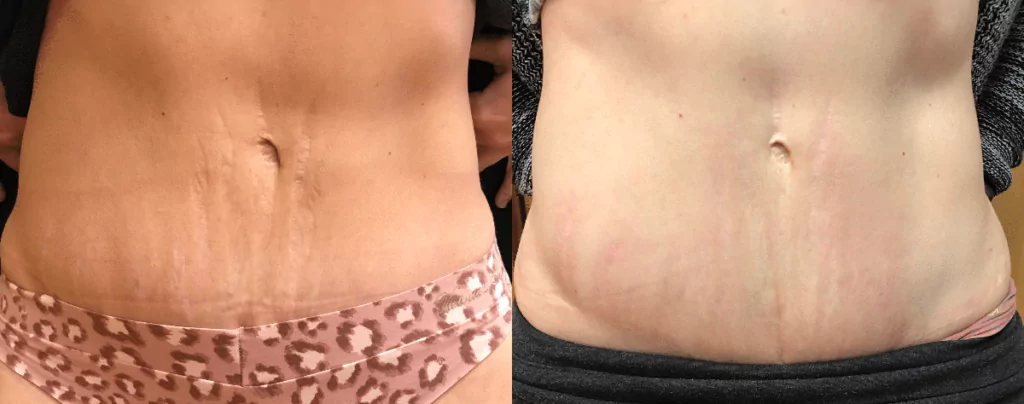
Fraxel Laser Pros
- Fraxel lasering is non-ablative, meaning it won’t vaporize the outer layer of skin. This makes it safer and less likely to cause hyperpigmentation.
- Fraxel lasers are highly effective in addressing a variety of skin concerns, including stretch marks, leaving you with healthy skin to feel proud and confident in.
- Fraxel lasers cause long-lasting results that appear within a few weeks.
Fraxel Laser Cons
- Laser treatments are often not advisable for those with darker skin, as it has a higher risk of causing persistent hypopigmentation as well as temporary post-inflammatory hyperpigmentation.
- Laser treatments do come with a couple of potential side effects, especially if the treatment is not performed well. Hypertrophic scarring, hyperpigmentation, and infection can occur. Acne or herpes can worsen with this procedure.
- After your treatment, you are likely to experience some swelling, redness, and tenderness for a few days. It’s important to keep your skin hydrated and protected from the sun.
How Can I Treat Stretch Marks With Topical Solutions?
Silicone Gels
Silicone gels are often touted as a preventative or treatment method for atrophic scars. While they probably won’t have the same significant effect on stretch marks as some other treatments, they are a helpful preventative measure when used early on during periods of weight fluctuations – like pregnancy – in which stretch marks are just developing or expected to form. It is believed that these silicone solutions increase hydration of the stratum corneum, encouraging fibroblast production, and, in turn, collagen synthesis, flattening scars and texture. Furthermore, a thin layer of silicone gel helps protect stretch marks and other scarring from environmental factors like bacteria and scratching caused by discomfort.
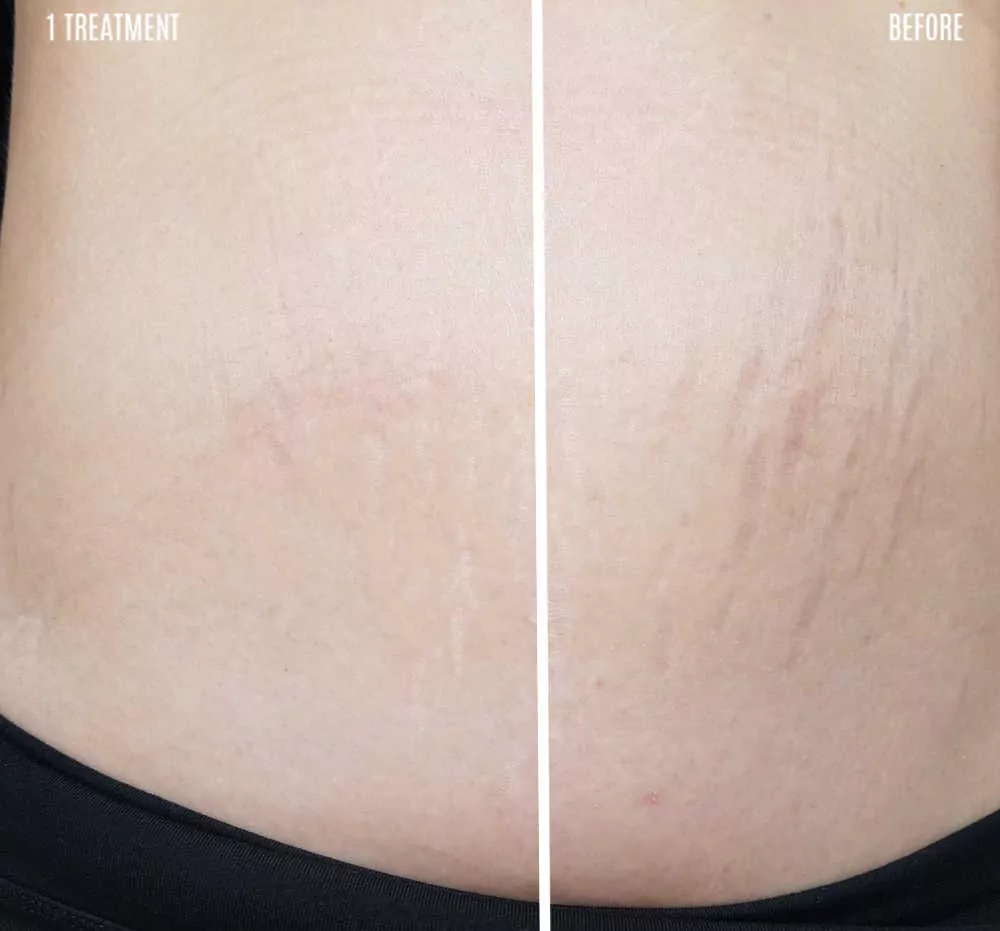
Murasaki Beauty Silicone Scar Gel
This gel is recommended to help combat scarring, stretch marks, wounds, burns, and other damage-induced textural issues early on. The formula is simple yet effective in keeping skin smooth and hydrated, allowing your body to carry on its natural healing process with a little extra boost and protection. This scar gel is designed to flatten skin texture while also relieving redness, itchiness, and discomfort that can often be an issue with stretch marks early on.
Silicone Gel Pros
- Silicone gel is easy to acquire and apply; it can generally be found in drugstores for a low price and is great for sensitive skin, generally not exhibiting adverse effects.
- Silicone gel boost hydration in the skin, leading to an overall more flattering and smooth appearance.
- Silicone gel does not clog pores which can make it a great option for those with sensitive or acne prone skin.
Silicone Gel Cons
- While it doesn’t hurt to try, silicone gel probably won’t cause a significant transformation in stretch marks.
- Silicone gel should be applied for 2 to 3 months to help prevent and treat scarring, a time period which may seem a bit long to some.
- Silicone gel sheets may not be suitable for those with certain skin allergies and can occasionally result in poor reactions, such as pruritis or skin rashes.
Retinoids and Retinols
Retinoids are a derivative of vitamin A that are often used to treat pigmentation and textural issues in the skin. They are the prescription version of retinoids, which you can buy OTC. Retinols penetrate into the dermis of the skin, where they neutralize free radicals and aid in the production of collagen, as well as boost the cell turnover of the skin. Tretinoin cream is a popular topical option for targeting stretch marks. It’s particularly effective for fresh stretch marks that can be targeted early.
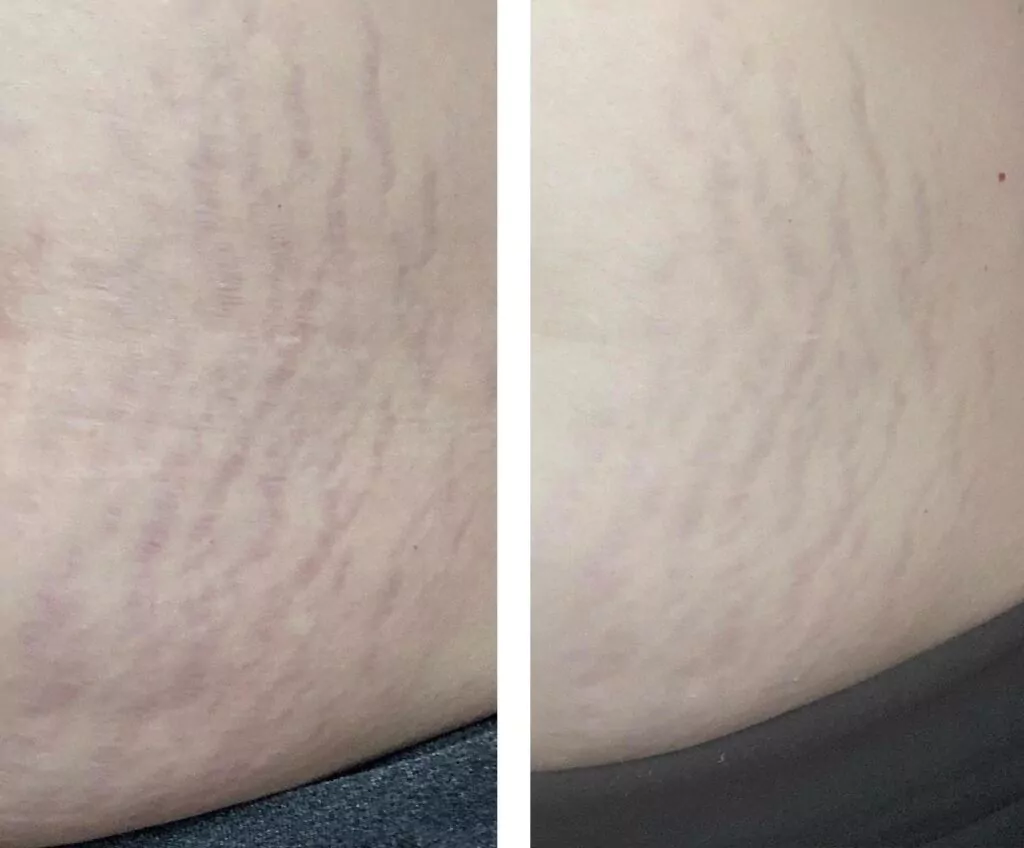
Paula’s Choice Retinol Skin Smoothing Body Treatment
Paula’s Choice is big in the skincare community, touting a long line of products addressing facial skin concerns – however, they also have products like this one that are specifically formulated to help improve the skin texture of the body. This treatment includes pure retinol at a concentration of 0.1% – this is a great place to start if you are new to retinols, as they can be drying at the beginning. A blend of antioxidants, emollients, and plant oils keep skin hydrated while also fighting free radicals that worsen the signs of aging.
Retinol Pros
- Retinoids have been proven to reduce the appearance of stretch marks in the skin when applied early on in the stretch mark-forming process; in fact, 80% of patients noticed improvements in their skin.
- Retinol helps combat other textural issues and prevent signs of early aging; it can also help those with acne scarring or other skin concerns.
Retinol Cons
- It should be noted that, if you are pregnant, you should not be using tretinoin cream. It can also cause redness or irritation in the skin.
- Retinoids make you sensitive to the sun, so be sure to wear sunscreen when using them. Most should also be used with a gentle moisturizer to prevent dryness and irritation.
Chemical Peels
Chemical peels are often recommended for a variety of textural concerns. When it comes to stretch marks, the effects of a chemical peel cause quicker cell regeneration, improving the surface texture of skin. They likely won’t cause stretch marks to go away completely, as they do not affect the underlying structure of the skin, but they can help make striae less visible and obvious. During a chemical peel treatment, an acidic solution sloughs off dead and useless skin cells to combat dullness and surface-level marks. These solutions usually contain AHAs, like glycolic acid or salicylic acid, or TCA (trichloroacetic acid), which breaks down excess connective tissue. More aggressive ingredients include phenol. Phenol penetrates deeper into the skin for a more intense exfoliation experience. This leaves behind healthier, more refreshed looking skin.
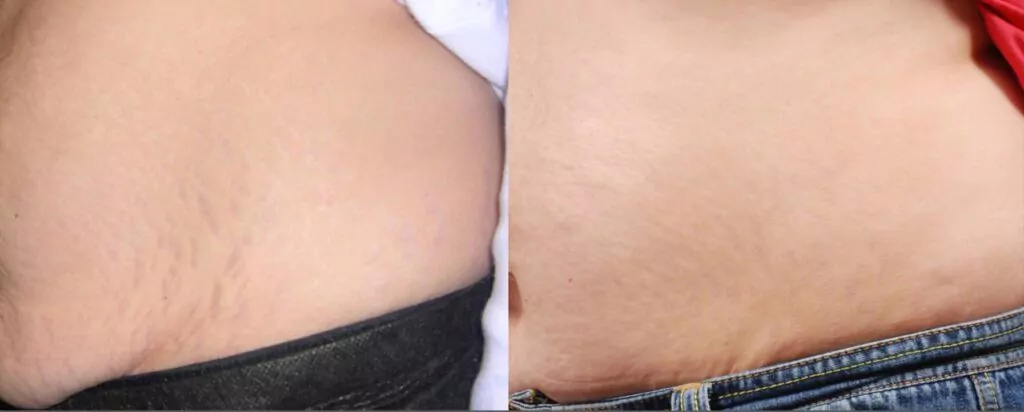
Chemical Peel Pros
- Chemical peels are moderately cost-effective, the cheapest ones costing as little as $150, which puts them somewhere between minimally invasive cosmetic procedures and OTC creams.
- Chemical peels can leave you with fresher, more luxurious looking skin.
- Chemical peels remove the top layer of skin, leaving behind a healthier, glowing surface.
- Chemical peels can also treat other superficial concerns, like acne scars and minor wrinkles.
Chemical Peel Cons
- Some chemical peels can venture on the more expensive side, costing up to $6000.
- Some more intense chemical peels can be painful and require anesthesia.
- A deep chemical peel often results in unflattering side effects, such as prolonged redness and dryness, as well as sun sensitivity.
- While chemical peels can help reduce the appearance of stretch marks, they rarely penetrate deeply enough to affect them very significantly.
- Darker skin types may experience more side effects and not be ideal candidates for chemical peels.
Moisturizing Creams
Certain creams containing ingredients like cocoa butter, glycolic acid, and vitamin A, and vitamin E are especially hydrating and moisturizing. Keeping your skin hydrated can help keep your skin barrier strong and durable. A lot of stretch marks tend to fade at least somewhat on their own over time; for more minimal cases, these ingredients give your skin the strength it needs to repair itself, while also preventing stretch marks or signs of aging from cropping up in the first place. Here are a couple of creams and lotions that are affordable options to help give you the supple and smooth skin you crave.

Body Boost Stretch Mark Butter: Milk and Honey
Body butters are ultra-rich and creamy ways to give your skin some extra TLC treatment. We love this formula for avoiding irritating ingredients – like fragrances, mineral oils, and parabens, making it safe even for pregnant women. Moisturizing ingredients like grapeseed, rosehip, jojoba, and borage oils feature linoleic acid (vitamin F), a plant-based fatty acid that conditions the skin and acts as an anti-inflammatory agent. With an extra dose of shea butter and gotu kola, this cream fortifies the skin barrier and prevents dryness from taking over, reducing the chance of damage and stretch marks wreaking havoc.
Drunk Elephant T.L.C Glycolic Body Lotion
Alpha hydroxy acids (or AHAs) are acids that are commonly used in anti-aging and skin rejuvenating products. The most commonly found AHAs are glycolic acid, lactic acid, citric acid, and hydroxycaproic acid. They work to refresh the skin’s surface by shedding dead skin cells – aka exfoliation – leaving behind a smoother epidermis. Regular exfoliation and hydration can reduce the severity of stretch marks. In this body lotion, for example, a 10% AHA blend of glycolic, tartaric, lactic, and citric acids works to speed up cell turnover and cleanse pores, aiding in collagen production. At the same time, marula butter (an antioxidant-rich emollient) and shea butter boost the skin’s barrier. Just be sure to apply sunscreen when using AHAs, as they bring about increased UV ray sensitivity.
Moisturizing Creams Pros
- These kinds of creams can be found in a variety of price ranges, making it a go-to option for those with a tight budget.
- Apart from treating stretch marks, moisturizing creams can help improve the look of skin overall, keeping it young and supple while strengthening it against environmental factors and the stresses of aging.
- Applying creams daily can be a wonderful self-care ritual that makes you feel good inside and out.
- Body creams are a very low-risk option for those who are worried about the effects of cosmetic procedures.
Moisturizing Creams Cons
- While they may be helpful in preventing stretch marks or even reducing their appearance in the early stages, topical creams are often not hugely effective; they probably won’t make a significant difference in severe stretch marks.
- Everybody has different reactions to certain ingredients; while plenty of creams are formulated specifically to avoid allergic reactions or sensitivities, some topical lotions may cause irritation depending on their ingredients.
Massage
Massages are often recommended to treat and prevent various scars. When it comes to stretch marks, regular massaging can help prevent them from forming in the first place; increased blood flow and circulation facilitate the cellular nutrient delivery and waste removal system in skin tissues. Massaging your stomach, thighs, arms, buttocks, or any other area in which stretch marks are likely to occur for a few minutes each day can help your body heal itself quickly and properly.
Massage Pros
- This is an easily accessible treatment that pretty much anyone can do – unless you have it done by a professional, it’s completely free.
- There are virtually no risks associated with a light, gentle massage.
- If you choose to see a professional, you can treat yourself with a spa day while working on your aesthetic look.
Massage Cons
- While a massage can help prevent early stretch marks, it is unlikely to improve the appearance of older or existing striae.
Final Takeaway
Stretch marks, striae, tiger stripes – whatever you call them, they can be the cause of some significant headaches and insecurities. But you don’t have to live with these irritating streaks forever; while stretch marks are notoriously stubborn and hard to find any miracle solutions for, there are plenty of options for minimizing their appearance while also improving the look of your skin overall. From luxurious cosmetic treatments to simple, affordable approaches, you don’t have to settle for your stretch marks forever. For a lot of women, striae is an unfortunate by-product of things that should be celebrated – like hitting puberty, achieving your dream body, giving birth, and maturing. Don’t let these skin marks keep you from enjoying your life and exhibiting the full confidence you deserve. With the proper care and attention, you can diminish the appearance of stretch marks to the point where they become banished to the farthest corners of you remind – and you can finally forget about them completely!
 info@skinlyaesthetics.com
info@skinlyaesthetics.com  212-774-4264
212-774-4264 
